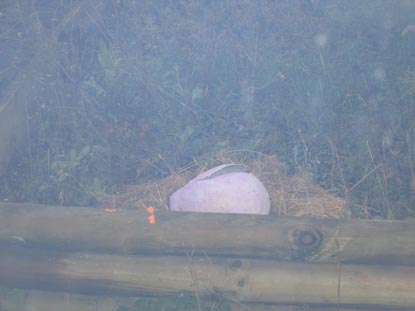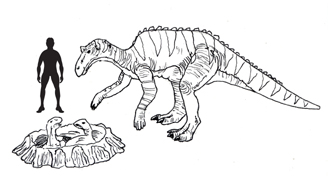School Pupils Waiting for Dinosaur to Hatch
Pupils at Willow Green Academy are getting “egg-cited” over the prospect of having their very own dinosaur egg hatch,all part of the term topic of dinosaurs which is currently being run with some classes for the next few weeks.
Dinosaur Egg
Rainbow fish class, the children who make up year 1, have been studying dinosaurs and other prehistoric animals and learning all about them with their teacher Miss Walker. A team member from Everything Dinosaur visited the budding young palaeontologists yesterday as part of the school’s scheme of work for this term. Lots of fossil handling and dinosaur exercises ensued and as a special treat some of the children took their visitor to show off the school’s very own dinosaur nest with a single, large, pink dinosaur egg, sitting snugly on a bed of hay.
There had been much excitement earlier in the week when the pupils discovered that the egg had cracked, so the dinosaur inside might be getting ready to hatch.
Willow Green Academy’s Dinosaur Egg
Picture credit: Everything Dinosaur
The Dinosaur Nest
The picture shows the large dinosaur egg, sitting securely in one of the school’s raised beds. It was decided not to get too close to the egg and to take a photograph of the nest through the window. After all, as one of the year 1 pupils pointed out, it was not a good idea to get too near just in case the nest was disturbed.
Imaginative lesson activities such as this can help to motivate and enthuse young children and tap into all sorts of areas related to key objectives of the national curriculum. For example, Miss Walker supported by the class’s teaching assistant Mrs Greenwood can encourage the children’s creative writing by getting them to compose letters to the baby dinosaur. The young pupils can design their own dinosaurs and have a go at coming up with their very own scientific names for their creations. Such activities will encourage the children to make observations, consider simple associations and patterns as well as to develop all important literacy skills.
Having been given one or two pointers about how dinosaurs moved by the visiting Everything Dinosaur expert, the Willow Green pupils could participate in a number drama based activities as they imagine what it would be like to be a dinosaur.
At Everything Dinosaur, we have conducted a number of similar schemes of work with primary school children. Lots of extension topic related activities can been devised, team members have been discussing the time when their baby dinosaur “hatched” promptly escaped and then sent the class various emails and pictures telling the children all about where in the world the dinosaur had travelled to. Using a world map, some pictures of famous land marks such as the leaning tower of Piza, the Pyramids of Giza and Victoria Falls all downloaded from the Internet, the dinosaur’s travels were plotted and this helped the pupils learn about famous landmarks and places in different countries.
Dinosauria Laid Eggs
As far as we know all members of the Dinosauria laid eggs but different types of dinosaur adopted different strategies when it came to looking after the nest and the newly hatched babies. For example, at one extreme some dinosaurs may have produced precocial offspring. Precocial offspring are born or hatched as relatively well-developed creatures that are able to move around very soon after birth and show a high degree of independence. Animals alive today that show this precocial behaviour include many birds such as ducks and geese plus mammals such as a number of hoofed animals. A young wildebeest for instance, can stand up and indeed run within a few minutes of being born. Many palaeontologists believe that the large, sauropods (long-necked dinosaurs such as Diplodocus), may have adopted this strategy, essentially abandoning the nest of eggs once they had been laid.
Maiasaura
However, other dinosaurs such as the ornithopod known as Maiasaura, whose fossils have been found in Cretaceous-aged strata from Montana (United States), seem likely to have looked after their young. These dinosaurs nested in large colonies, just like many birds do today. Studies of fossilised, young Maiasaura hind limbs indicate that the leg bones were not fully formed (ossified) when these dinosaurs hatched. These hatchlings were not able to leave the nest. Youngsters were not able to walk and so depended on the adults to bring them food. This research, coupled with the large amount of crushed eggshell associated with the site in Montana, indicates that the young Maiasaura stayed in the nest for some time – looked after by parents. This is an example of altricial behaviour, where adults dedicate a great deal of time and effort to looking after babies and juveniles. Animals alive today that demonstrate this behaviour include cats, dogs, our own species, marsupials and most garden birds.
An Illustration of Maiasaura next to her Nest
Picture credit: Everything Dinosaur
The name Maisaura means “Good Mother Lizard”. It is very likely that members of the Dinosauria exhibited altricial and precocial behaviour, with a number of genera showing intermediate behaviours between these two extremes.
For dinosaur models and figures, take a look at the Wild Safar Prehistoric World section of the Everything Dinosaur website: Wild Safari Prehistoric World Models.




Leave A Comment